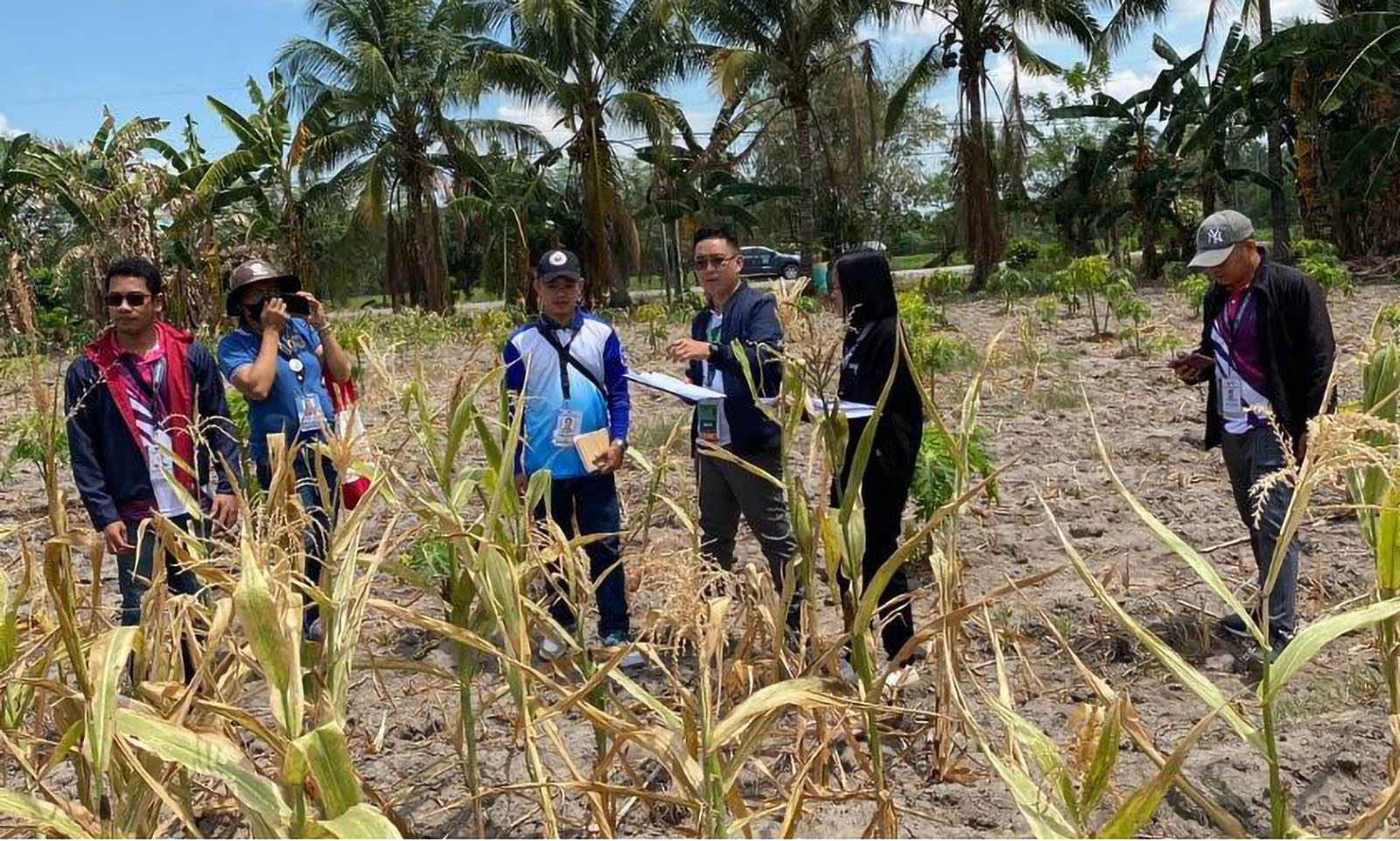
CALAMITY Local technicians in South Cotabato assess crops wilted by the intense heat. The province was placed under a state of calamity on Friday. —PROVINCIAL DISASTER RISK REDUCTION MANAGEMENT OFFICE-SOUTH COTABATO PHOTO
The monthslong drought caused by extreme heat and lack of rain has bludgeoned the country’s crop and livestock production, with damage rising to P4.3 billion this week, according to the Department of Agriculture (DA).
In a bulletin posted on Friday, the DA said agricultural losses recorded on April 23 were higher than the P3.94 billion reported a week earlier.
READ: South Cotabato under state of calamity due to drought
Rice was the crop most affected by the dry spell, accounting for 61.71 percent of the total damage, or 113,446 metric tons worth P2.71 billion from 50,511 hectares.
High-value crops comprised 19.8 percent, or P869.34 million, of overall agriculture losses, while corn constituted 17.53 percent, or P769.68 million.Other crops, livestock and poultry accounted for the remaining 1 percent, or P42.1 million.
The regions affected by the El Niño-induced drought are Cordillera, Ilocos, Cagayan Valley, Central Luzon, Calabarzon (Cavite, Laguna, Batangas, Rizal and Quezon), Mimaropa (Mindoro, Marinduque, Romblon and Palawan), Bicol, Western Visayas, Zamboanga Peninsula, Davao and Soccsksargen (South Cotabato, Cotabato, Sultan Kudarat, Sarangani and General Santos).
A state of calamity due to the prolonged drought has been declared by local officials in 103 cities and municipalities and six provinces as of April 26.
READ: El Niño crop damage now at P3.9B
The DA estimated the volume of production loss at 184,002 MT spanning 77,731 ha.
The department has extended about P2.16 billion worth of assistance to affected farmers and fishers, including P1.1 billion in financial aid to rice farmers and P8 million in rice machinery and equipment.
The DA is also providing fertilizers, planting materials, irrigation pumps and engines, and various farm inputs through its regional offices.
Disaster-prone
Meanwhile, the United Nations called on the international community to increase its support for the country as it deals with what it described as a “serious drought” caused by one of the strongest El Niño episodes in history.
Local UN officials noted that the dry spell had affected more than 1.4 million people in the Philippines where the upcoming harvest was expected to be below average.
The Climate Crisis Coordinator for the El Niño/La Niña Response, UN Assistant Secretary General Reena Ghelani, who ended her weeklong visit to the Philippines on Wednesday, said the country had demonstrated the importance of “acting early before a disaster strikes.” “With more frequent and severe climate shocks, it is crucial we strengthen our support to community resilience,” she said.
According to the United Nations, the Philippines is one of the world’s most disaster-prone countries and is highly vulnerable to climate change. Disasters have already cost $23 billion in damage to the country since 1990, it said.
UN Resident and Humanitarian Coordinator in the Philippines Gustavo Gonzalez said they were “recalibrating” their technical assistance for the country amid the relentless heat.
On Friday, a special session of the South Cotabato Provincial Board unanimously agreed to place the province under a state of calamity after its agricultural losses had climbed to over P200 million, according to Board Member Junette Hurtado.
South Cotabato is the fourth province in Mindanao to have declared a state of calamity due to the El Niño weather phenomenon. The others are Sultan Kudarat, Basilan and Maguindanao del Sur.
Throughout Mindanao, at least 20 towns have been placed under a state of calamity. Zamboanga City was the first to declare after the long dry spell depleted its potable water supply.
Drought upland
In Luzon, the extreme heat is wilting the rice planted in the famed rice terraces in the Cordillera region as their unique engineering system for conserving rainwater could not cope with the long dry spell, DA officials said on Thursday.
A DA team has been documenting the conditions of farms struck by the drought from forested Itogon town in Benguet to Apayao province, according to Charles Picpican, the DA project evaluation officer.
The weather bureau predicted extreme heat for “mountainous Luzon” at least until June.
Picpican said all mountain farms generally suffered low rainfall, including the vegetable gardens in Benguet province which are carved on the sides of mountains, the stone-walled terraces of Mountain Province and the picturesque rice terraces of Ifugao, which collectively make up one of the country’s World Heritage Sites.
Ifugao has been the hardest drought-hit upland province, accounting for an estimated damage of P232 million out of the total P444 million losses throughout the Cordillera, according to Jennilyn Dawayan, the DA Cordillera director, who cited a DA inventory report in March.
El Niño had disrupted “water availability, and aquifers have not been recharging even in areas like Ifugao,” based on initial observations, she said. Ifugao terrace farmers produce homegrown grains like Tinawon, which are classified as heirloom rice because of their rarity.
Picpican said he was unaware if the region’s drought losses included rice terrace production, which is traditionally grown for household or community consumption.
The Rice Data Analytics Dashboard of the Philippine Rice Research Institute said Ifugao produced 34,202 MT in 2023 but did not say whether they included heirloom grains.
In 2005, terrace farmers grew heirloom rice for export to the United States, selling up to 97 MT of Tinawon and Unoy grown in Kalinga province, according to the Food and Agriculture Organization (FAO).
The Ifugao terraces were designated as a combined World Heritage Site in 1995.
In 2011, it was recognized as a globally important agricultural heritage system by the FAO. —WITH REPORTS FROM BONG S. SARMIENTO, VINCENT CABREZA AND INQUIRER RESEARCH